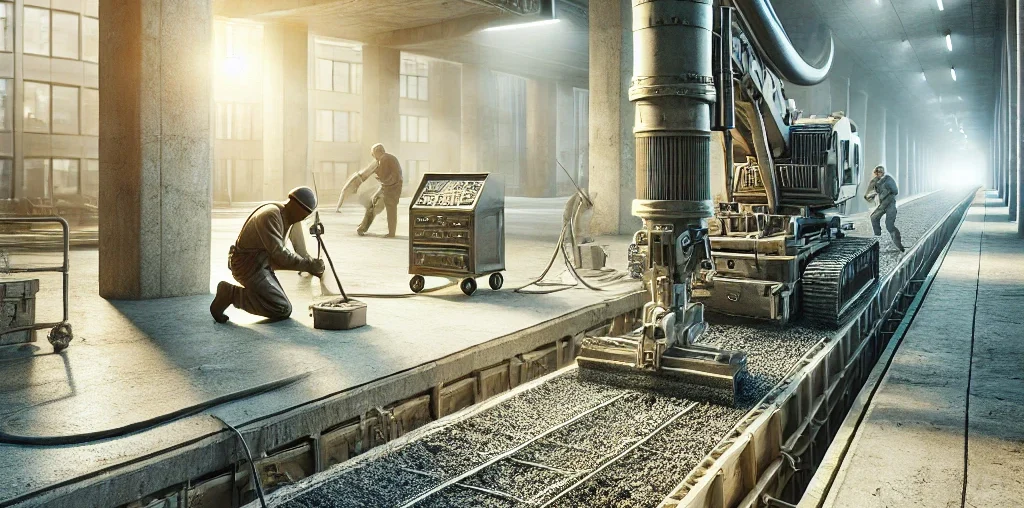Concrete is considered to be almost maintenance-free as a building material, but over the years carbonation and corrosion leave their mark here too. To avoid long-term damage, the surfaces should be repaired in good time. Modern concrete replacement systems make the processes on the construction site easier.
Whether in tunnels, bridges or parking areas – reinforced concrete can be found everywhere in our built environment, and has been for quite some time. Accordingly, many of these structures are now showing their age. Corrosion damage and flaking are increasingly evident in the material, which is considered indestructible. This is partly due to the fact that the quality did not meet today’s requirements until well into the 1970s.
But faulty processing, overwatering of the fresh concrete, inadequate compaction or delays during installation and, in particular, insufficient concrete cover are also reasons for increased damage. The repair of concrete components is regulated in DIN EN 1504. The Technical Rule for the Maintenance of Concrete Structures (TR Maintenance) provides further assistance and regulations.
Corrosion affects reinforced concrete
The chemical properties of concrete generally provide excellent protection for the reinforcing steel against corrosion. The alkaline environment (pH value >12) of the cement stone it contains protects the steel from rusting through. However, this alkalinity is reduced over time by external influences such as water pollution and carbon dioxide from the air. Strong freeze/thaw cycles, high chloride pollution from the introduction of road salt, acid rain, other acids as well as abrasion and wear also attack the concrete.
Especially in areas with heavy traffic, the salt is worked deeper into the concrete with every rain. If the natural corrosion protection is lost through this so-called carbonation, the steel begins to rust and over time pushes away the covering concrete shell.
Pro Tip: Looking for expert concrete contractors in Guelph? We offer high-quality concrete services, including driveways, patios, and foundations. Get a free quote today!
The right renovation concept
If a tradesman’s business is commissioned to repair damaged concrete surfaces, a coordinated renovation concept should first be developed based on a comprehensive damage analysis. This begins with various tests on components and substrates, which are used to determine the current condition of the structure. In addition to measuring the concrete cover, the carbonation depth and the chloride content, the strength of the substrate is also determined.
The appropriate renovation system is then selected based on the results of the preliminary investigations. Depending on the type of damage and the components affected, a combination of different concrete replacement systems for supports, pillars, bases and floor areas is recommended.
Expose and clean damaged areas
Before the actual repair work can begin, however, loose concrete parts must be removed by chiseling and blasting and the corroded reinforcement must be exposed. The use of high-pressure water jet technology (HDW) has proven to be effective for the complete or partial removal of damaged areas on concrete floors. The reinforcing steel must then be cleaned in accordance with the standard requirements; when using the corrosion protection product “weber.rep KB duo”, for example, to a surface cleanliness level of “SA 2.5”. The surface tensile strength of the cleaned and load-bearing prepared substrate must be at least 1.5 N/mm 2 on average.
Corrosion protection and reprofiling in the surface
The first step in repair involves reprofiling defects and breakouts. In classic concrete repair, four work steps must be carried out using four different products as standard. Multifunctional products such as the concrete replacement system “weber.rep duo”, on the other hand, consist of just two products: “weber.rep KB duo” combines corrosion protection and bonding agent, “weber.rep R4 duo” is both repair mortar and fine filler in one product. This simplifies handling and storage and thus speeds up the construction process. The plastic-modified, cement-bound concrete replacement system from Saint-Gobain Weber meets the highest requirements class of DIN EN 1504-3: Class R4.
After the walls and pillars have been reprofiled accordingly, the next step is to seal the base against moisture ingress. According to DIN EN 1504-2 / TR Maintenance, concrete components exposed to moisture and salt must also be protected with an appropriate surface system, usually systems of class OS5b. With a new development, Saint-Gobain Weber has succeeded in covering both applications with one product: “weber.tec Superflex OS5b” has both the OS5b surface protection certificate for concrete components and the general building inspection certificate (abP) as a seal in accordance with the FPD guideline.
Pro Tip: Upgrade your home with a durable concrete driveway in Guelph. Get expert installation, repairs, and custom designs. Contact us today for a free quote!
2-component coating
The 2-component coating is highly flexible and crack-bridging. The material sets quickly and reactively, is water-tight after just 24 hours and can be easily filled and sprayed, plastered or painted over. “weber.tec Superflex OS5b” provides long-term protection for concrete components against carbonation and damage caused by chlorides. According to the DIN EN 1504-2 standard and the technical rules for the maintenance of concrete components (TR Maintenance), it is suitable for use on vertical concrete surfaces in building and civil engineering. The protection system is flexible at temperatures down to -20°C and can therefore also be used outdoors without any problems. It is also resistant to aggressive de-icing salt.
Flowable concrete replacement mortar for large floor areas
For the renovation of concrete floor surfaces, a flowable concrete replacement mortar is recommended, such as “weber.floor 4640 Outdoor RepFlow”. The product is a repair mortar and leveling compound in one and is classified in the highest class R4 according to DIN EN 1504-3. This means that it is suitable for statically relevant requirements according to European standards. The concrete replacement mortar has a very high strength of CT-C50-F7 and can be used directly for medium loads. Thanks to its pumpable consistency, repair work can be completed quickly.
Further time savings can be achieved by using mobile silo technology. The Weber “MixMobil”, for example, enables a continuous supply of loose goods and thus seamless, time- and energy-saving processing. The material is mixed on site and pumped to the site. Processing takes place while standing. In this way, 8 to 12 tons of material can be conveyed per hour. Renovating over a thousand square meters a day is therefore no problem. After around 7 days, a suitable surface protection system, such as OS8, can then be applied.



